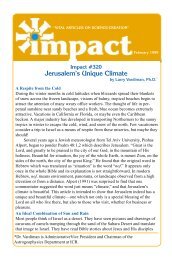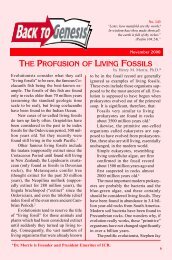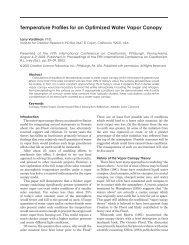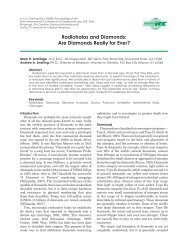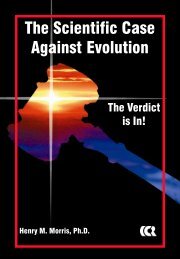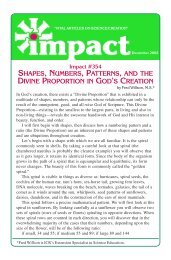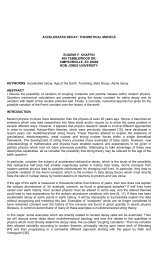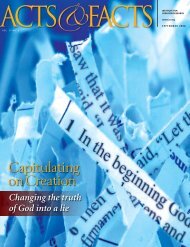650 Steven W. Boyd<strong>of</strong> events is important. Sometimes the characters march <strong>in</strong> place. Timespeeds up, slows, stops or even goes backwards—but only <strong>for</strong> a shorttime. Shortly, the <strong>in</strong>exorable sequence resumes. Time is l<strong>in</strong>ear <strong>in</strong>narrative. Not so <strong>in</strong> poetry.4. <strong>Statistical</strong> Study: Exploratory PhaseThe discussion above shows that characteristic features <strong>of</strong> poetry arealso found <strong>in</strong> narrative. The converse is also true: characteristic features<strong>of</strong> narrative are also present <strong>in</strong> poetry. We conclude that qualitativedescriptions <strong>of</strong> poetry and prose—although helpful <strong>in</strong> identify<strong>in</strong>g theirgenre—do not rigorously dist<strong>in</strong>guish them. We turn <strong>in</strong>stead there<strong>for</strong>e toexam<strong>in</strong>e countable features <strong>of</strong> texts, which admit a statistical analysis.As argued above, parallelism is not easily quantifiable, and, there<strong>for</strong>e,this most prevalent l<strong>in</strong>guistic feature <strong>of</strong> <strong>Biblical</strong> <strong>Hebrew</strong> poetry cannotbe used to dist<strong>in</strong>guish prose from poetry. But <strong>Biblical</strong> <strong>Hebrew</strong> has otherl<strong>in</strong>guistic features, which are easily counted, measurable characteristics,such as morphological distribution, word order, and clause length. 374.1 The Distribution <strong>of</strong> F<strong>in</strong>ite Verbs <strong>in</strong> <strong>Biblical</strong> <strong>Hebrew</strong>Although it would be ideal to look at all <strong>of</strong> these features,morphological distribution was the easiest to determ<strong>in</strong>e and, whatis more, prelim<strong>in</strong>ary tests <strong>in</strong>dicated that prose and poetry ev<strong>in</strong>cestrik<strong>in</strong>gly different distributions with respect to this countable feature.The specific morphological distribution chosen was the distribution <strong>of</strong>f<strong>in</strong>ite verbs, verbs <strong>in</strong>flected <strong>for</strong> person (1st—I, we; 2nd—you; 3rd—he, she, they) as well as gender (mascul<strong>in</strong>e and fem<strong>in</strong><strong>in</strong>e) and number(s<strong>in</strong>gular and plural). 38The distribution <strong>of</strong> f<strong>in</strong>ite verbs should be ideal <strong>for</strong> ascerta<strong>in</strong><strong>in</strong>g if atext is a narrative. S<strong>in</strong>ce narratives are characterized by an attention tosett<strong>in</strong>g, plot, characterization, and po<strong>in</strong>t <strong>of</strong> view (narrator)—with plotas arguably the most important—we need to f<strong>in</strong>d a countable l<strong>in</strong>guisticfeature, which reflects the action <strong>of</strong> characters unfold<strong>in</strong>g <strong>in</strong> time.F<strong>in</strong>ite verbs carry the ma<strong>in</strong> action. The other verb <strong>for</strong>ms <strong>in</strong> <strong>Biblical</strong>
Evidence <strong>for</strong> an Historical Read<strong>in</strong>g <strong>of</strong> Genesis 1:1–2:3 651<strong>Hebrew</strong> do not. Inf<strong>in</strong>itive constructs provide the sett<strong>in</strong>g, <strong>of</strong>ten mark<strong>in</strong>g acircumstantial clause. Volitives (jussives, imperatives, and cohortatives)<strong>in</strong>dicate what one <strong>in</strong>dividual wants the action <strong>of</strong> himself (s<strong>in</strong>gularcohortative) or others (jussive, imperative, and plural cohortative) tobe, but it is not that action. Inf<strong>in</strong>itive absolutes modify f<strong>in</strong>ite verbs.Participles are used attributively, substantively, or predicatively (asverbs). When they are used this last way they do not <strong>in</strong>dicate the ma<strong>in</strong>action.There are four f<strong>in</strong>ite verb <strong>for</strong>ms <strong>in</strong> <strong>Biblical</strong> <strong>Hebrew</strong> (see Glossary,p. 725): the preterite (wayyiqtol), the imperfect (yiqtol), the perfect(qatal) and the waw-perfect (w•qatal). Rarely, the preterite occurswithout the <strong>in</strong>itial waw patach (or qamets) be<strong>for</strong>e the prefix (such as <strong>in</strong>the last two verbs <strong>of</strong> Psalm 8:6) and, there<strong>for</strong>e, could be misconstruedas an imperfect, but <strong>for</strong> the most part it is a sequential past tense. 39 Of allf<strong>in</strong>ite verbs the distribution <strong>of</strong> preterites with<strong>in</strong> the f<strong>in</strong>ite verbs shouldmost clearly mark whether a passage is track<strong>in</strong>g events through time.The imperfect can be a present/future, general present or modal whenthe action is ongo<strong>in</strong>g or anticipated or it can express habitual actionwhen the action is <strong>in</strong> the past.Preterites with prefixed waw-consecutives must come first <strong>in</strong> asentence. If another syntactic element is fronted (it comes first <strong>in</strong> thesentence <strong>in</strong>stead <strong>of</strong> the verb to <strong>in</strong>dicate a contrast), the verb cannot bea preterite, but will usually be a perfect. The perfect is normally a nonsequentialpast tense, although word order constra<strong>in</strong>ts demand that itbe used <strong>in</strong> a sequential sense if an explicit subject precedes what wouldotherwise be a preterite.The waw-perfect is per<strong>for</strong>ce clause <strong>in</strong>itial and is used to expresshabitual action <strong>in</strong> the past and sequential action <strong>in</strong> the future. It cont<strong>in</strong>uesthe <strong>for</strong>ce <strong>of</strong> the verbs that precede it. It is <strong>of</strong>ten found <strong>in</strong> proceduralliterature, such as the <strong>in</strong>structions <strong>for</strong> assembl<strong>in</strong>g the tabernacle(Exodus 25–31).4.2 <strong>Statistical</strong> Study: Two QuestionsThe statistical portion <strong>of</strong> this study asks two pert<strong>in</strong>ent questions.
- Page 1 and 2: Chapter 9Statistical Determination
- Page 3 and 4: Evidence for an Historical Reading
- Page 6 and 7: 636 Steven W. Boydan historical rea
- Page 8 and 9: 638 Steven W. Boydapproaches this t
- Page 10 and 11: 640 Steven W. BoydThe coherence pri
- Page 12 and 13: 642 Steven W. Boyd3. Problems of a
- Page 14 and 15: 644 Steven W. Boydformat, but the t
- Page 16 and 17: 646 Steven W. Boydis too subjective
- Page 18 and 19: 648 Steven W. Boydthey are highly s
- Page 22 and 23: 652 Steven W. BoydThe first questio
- Page 24 and 25: 654 Steven W. Boyd0.8037Ratio of Pr
- Page 26 and 27: 656 Steven W. Boydensured the stati
- Page 28 and 29: 658 Steven W. Boyd1.00.90.80.70.60.
- Page 30 and 31: 660 Steven W. Boyd1.00.90.80.70.60.
- Page 32 and 33: 662 Steven W. BoydAs in Figures 6 a
- Page 34 and 35: 664 Steven W. Boydmodel with all B
- Page 36 and 37: 666 Steven W. Boydfor a one variabl
- Page 38 and 39: 668 Steven W. BoydClassification wa
- Page 40 and 41: 670 Steven W. Boydpoetry.With this
- Page 42 and 43: 672 Steven W. Boydentire population
- Page 44 and 45: 674 Steven W. Boyd1.00.9Probability
- Page 46 and 47: 676 Steven W. Boydnot poetry, with
- Page 48 and 49: 678 Steven W. BoydAbraham is noted
- Page 51: Evidence for an Historical Reading
- Page 54 and 55: 684 Steven W. Boydto Ashdod, they
- Page 56 and 57: 686 Steven W. Boydthe account of th
- Page 58 and 59: 688 Steven W. BoydBalaam tried to c
- Page 60 and 61: 690 Steven W. BoydI have given Ar a
- Page 62 and 63: 692 Steven W. Boydtruth claim of in
- Page 64 and 65: 694 Steven W. Boyd(3) the Samson pe
- Page 66 and 67: 696 Steven W. BoydImperfects/Finite
- Page 68 and 69: 698 Steven W. BoydAlso, logistic re
- Page 70 and 71:
700 Steven W. BoydTable B4. Finite
- Page 72 and 73:
702 Steven W. BoydTable B8. Finite
- Page 74 and 75:
704 Steven W. Boydcoefficients mode
- Page 76 and 77:
706 Steven W. BoydaThis story does
- Page 78 and 79:
708 Steven W. BoydTable D5. Chronol
- Page 80 and 81:
710 Steven W. BoydTable D6. Functio
- Page 82 and 83:
712 Steven W. BoydTable D8. Tempora
- Page 84 and 85:
714 Steven W. Boydseventh day, and
- Page 86 and 87:
716 Steven W. Boydas a standard for
- Page 88 and 89:
718 Steven W. Boydpoetic sensibilit
- Page 90 and 91:
720 Steven W. Boydby what precedes
- Page 92 and 93:
722 Steven W. Boyd43. Pampel [2000,
- Page 94 and 95:
724 Steven W. Boyd57. These were id
- Page 96 and 97:
726 Steven W. Boydthe major disjunc
- Page 98 and 99:
728 Steven W. Boydpp. 321-334, Zond
- Page 100 and 101:
730 Steven W. BoydFokkelman, J. P.,
- Page 102 and 103:
732 Steven W. BoydUniversity Press,
- Page 104:
734 Steven W. BoydWeil, G. E., Bibl



